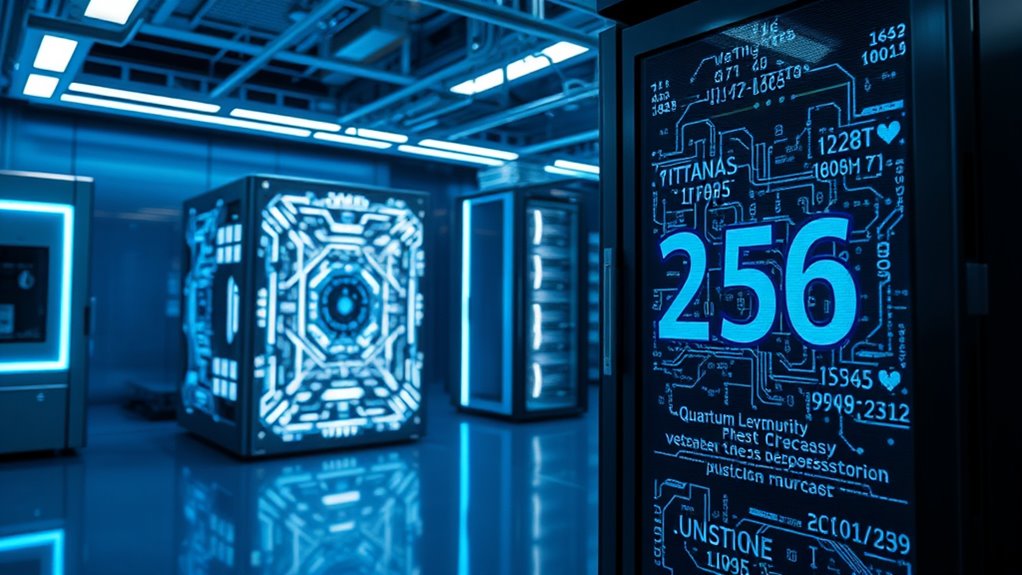Currently, quantum computers lack the power to threaten SHA-256’s security, making the risk mostly theoretical. While algorithms like Grover’s could halve the encryption’s strength in the future, large-scale quantum machines are still unfeasible. Experts agree that practical vulnerabilities are distant, and SHA-256 remains secure for now. If you want to understand the timeline and ongoing efforts to prepare for quantum threats, you’ll find plenty of insights ahead.
Key Takeaways
- Current quantum computers lack the capacity to practically break SHA-256’s security.
- Grover’s algorithm could theoretically halve SHA-256’s security, but is not feasible with existing hardware.
- Larger hash functions like SHA-512 are considered safer against future quantum attacks.
- Quantum threats mainly target asymmetric encryption, not symmetric hashes like SHA-256.
- Practical risks from quantum computing to SHA-256 remain distant due to hardware and algorithm limitations.

Have you ever wondered if quantum computers could someday break the security of SHA-256? Right now, the answer is no. Quantum computers, as they stand today, aren’t powerful enough to compromise SHA-256 in a practical sense. While quantum technology continues to advance, current machines lack the scale and stability needed to perform the complex calculations required to break this hash function. Theoretical developments in quantum algorithms like Grover’s could pose a risk by halving the effective security level of symmetric keys, including those used in SHA-256. But this remains purely theoretical at this stage, as implementing such algorithms at scale isn’t feasible with existing hardware. SHA-256 remains robust against quantum attacks in practice, thanks to its design and the current limits of quantum computing. Quantum advantage is necessary to make such attacks viable, and it has not yet been achieved. The complexity of quantum algorithms further complicates breaking SHA-256. Researchers are exploring quantum implementations of various hash functions, but these typically take longer to execute than classical algorithms. Quantum circuits for hashing are intricate and demand significant computational resources, making their practical use unlikely anytime soon. Additionally, larger hash functions like SHA-512 are viewed as safer bets for future-proofing cryptographic security, especially if quantum threats become more tangible. For now, SHA-256’s collision resistance and overall security hold firm, and no practical method exists to crack it with quantum technology. This means that, in real-world applications like Bitcoin, SHA-256 continues to serve effectively. Bitcoin’s proof-of-work mechanism relies on SHA-256, and while quantum computers could someday challenge this, today, they’re not a threat.
Despite the hype, the threat from quantum computers to cryptography isn’t imminent. Quantum attacks on asymmetric cryptography, such as RSA or ECC, are more immediate concerns, but SHA-256 isn’t directly affected by these. The main quantum concern for symmetric encryption is Grover’s algorithm, which can reduce security by roughly half. Doubling key lengths, like moving from SHA-256 to SHA-512, can mitigate this risk. Developers and cryptographers are actively researching quantum-resistant algorithms, aiming to prepare for a future where quantum computers might be more capable. For now, the timeline for a quantum breakthrough that could realistically threaten SHA-256 remains distant. While quantum computing offers fascinating possibilities, its current limitations mean SHA-256’s security remains solid. It’s important to distinguish between theoretical risks and practical vulnerabilities, and at this point, SHA-256 remains a trustworthy cornerstone of digital security. As research progresses, understanding the quantum limitations of current hardware helps clarify the realistic timeline for future threats.
Frequently Asked Questions
How Soon Could Quantum Computers Actually Crack SHA-256?
Right now, quantum computers can’t crack SHA-256, and experts believe it’s at least 20 to 30 years away. You don’t need to worry about immediate threats, since current tech lacks enough qubits and error correction. While progress is rapid, the enormous technical challenges mean quantum attacks on SHA-256 remain a distant future. Staying informed and adopting quantum-resistant cryptography now can help you stay secure long-term.
What Are the Current Limitations of Quantum Computing Technology?
You should know that current quantum computers face significant limitations. Their qubits are highly sensitive to environmental disturbances, leading to errors, and maintaining quantum coherence is difficult. Scaling up to millions of qubits requires enormous engineering efforts and energy. Additionally, hardware lacks standardization, and quantum software is still developing. As a result, today’s devices mainly handle niche problems and aren’t yet ready for broad, reliable application.
Are There Existing Quantum-Resistant Cryptographic Algorithms?
You’re probably relieved to hear there are indeed quantum-resistant algorithms, so your data isn’t doomed just yet. Thanks to NIST’s efforts, algorithms like CRYSTALS-Kyber and Dilithium are now standardized, designed to withstand future quantum threats. They rely on tough math problems that even quantum computers struggle with. So, instead of panicking about quantum supremacy, you can rest easy knowing your digital security is evolving to stay a step ahead.
How Does Quantum Error Correction Impact Practical Quantum Computing?
Quantum error correction is essential for making practical quantum computing a reality. It helps you protect quantum information from errors caused by noise and decoherence, allowing longer and more complex calculations. By encoding logical qubits into multiple physical qubits, QEC reduces error rates exponentially. This enables your quantum processors to run fault-tolerant algorithms reliably, bringing scalable, real-world quantum applications closer to you and advancing the field considerably.
What Industries Are Most at Risk From Quantum-Enabled Attacks?
You might think only tech or finance sectors face quantum threats, but evidence shows critical infrastructure and healthcare are equally vulnerable. Quantum attacks could compromise energy grids, water supplies, and patient data, risking widespread disruption and loss of trust. While many organizations haven’t yet adopted post-quantum security measures, understanding these risks highlights the urgent need for all industries to prepare, ensuring their systems stay secure against future quantum-enabled attacks.
Conclusion
As quantum computers inch closer to breaking traditional encryption, the stakes feel higher than ever. While today’s SHA-256 remains secure, the threat of future breakthroughs looms. Will quantum tech disrupt our digital trust before we’re ready? The answer isn’t clear—and that uncertainty keeps you on edge. One thing’s certain: staying informed and adaptable now could be your best defense against an unpredictable, quantum-powered tomorrow.









